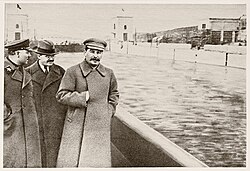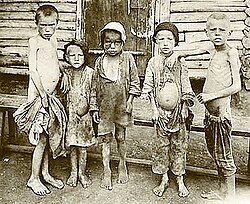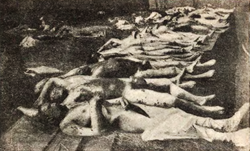
The Great Terror (1936–1938) was one of the most brutal and extensive campaigns of political repression in Soviet history, orchestrated by Joseph Stalin to consolidate his power and eliminate perceived enemies of the state. The purge targeted not only high-ranking party officials but also intellectuals, military leaders, ordinary citizens, and marginalized groups. This period, marked by mass arrests, forced confessions, executions, and deportations to the Gulag labor camps, profoundly reshaped Soviet society and left a lasting scar on both the nation and the broader global perception of the Soviet regime.
Research your ancestors on MyHeritage
Origins and causesOrigins and causes
The roots of the Great Terror can be traced to Stalin's desire to secure absolute authority within the Communist Party. After the death of Vladimir Lenin in 1924, Stalin’s rise to power was marked by fierce political rivalries. By the mid-1930s, Stalin viewed any form of dissent— real or imagined — as a threat to his rule. The assassination of Sergei Kirov, a prominent party leader, in 1934 provided the pretext for a crackdown on "enemies of the people." Scholars debate whether Kirov’s murder was orchestrated by Stalin himself, but it undeniably marked the beginning of a more radical phase of repression.

While Kirov's assassination might have been a trigger to the outburst of the Great Terror, historians are still debating the causes of the Great Terror, particularly Stalin’s motivations for ordering mass repression. One significant factor that may have influenced Stalin’s plans was the worsening situation in the Soviet Union due to a renewed famine outbreak. The country’s agriculture, already weakened by collectivization, struggled to provide sufficient food supplies even in relatively good harvest years. The year 1936 was marked by poor crop yields. Numerous reports from various regions, some addressed directly to Stalin, indicated widespread famine and starvation from the autumn of 1936 to the spring of 1937. The situation in cities also deteriorated sharply as starving peasants, despite numerous obstacles, flocked to urban areas in desperate search of bread.[1] In addition to economic factors, foreign policy concerns also played a role — as the communists faced defeat in Spain and Adolf Hitler's popularity surged in Germany, a wave of spy mania swept through the Soviet Union.[2]
On July 30, 1937, the NKVD issued Secret Order No. 00447, which is widely regarded as the starting point of the Great Terror. In the summer of 1937, a series of state-led repressive campaigns began, collectively referred to today as the Great Terror. The term was first coined by British historian Robert Conquest in the late 1960s and gained widespread use in Russia after Perestroika.[3] During this period of political repression, spanning 1937 to 1938, at least 1.7 million individuals were arrested in the Soviet Union, with over 700,000 of them executed.[4] The campaign targeted alleged "enemies of the people," "counter-revolutionaries," and "saboteurs," along with their families and associates.
Key events of the purgeKey events of the purge

The Moscow Trials of 1936 can be considered a precursor to the Great Terror. They were a series of show trials in which prominent Bolsheviks, including Grigory Zinoviev, Lev Kamenev, and Nikolai Bukharin, were forced to confess to fabricated charges of treason, espionage, and counter-revolutionary activities. These confessions were typically obtained through torture and psychological coercion. The trials were widely publicized to demonstrate the supposed threat posed by internal enemies, creating a climate of fear and suspicion.
The purge expanded beyond party elites to include the military. The Red Army, under the leadership of Marshal Mikhail Tukhachevsky, was decimated, with many high-ranking officers executed or imprisoned. This purge had devastating consequences for Soviet military preparedness, particularly in the early stages of World War II.
The terror also extended to ordinary citizens through the activities of the NKVD (the Soviet secret police). Mass arrests were conducted based on arbitrary quotas, with local officials encouraged to meet or exceed targets for identifying "enemies of the state." Those arrested faced execution or deportation to Gulag camps, where harsh conditions led to high mortality rates.
Nikolai Yezhov, the People's Commissar for Internal Affairs, acting under Stalin's direction, became one of the key figures responsible for organizing the mass repressions of 1937–1938. The year 1937, during which Yezhov headed the NKVD, became a symbol of the repressive policies, and the peak of Soviet political purges came to be referred to as "Yezhovshchina" — a term that directly ties the period to Yezhov's leadership.
Consequences and legacyConsequences and legacy
During the period of 1937–1938, at least 725,000 people were executed under political charges, and over 1.7 million were arrested. According to historian Viktor Zemskov[4], between 681,000 and 692,000 of those executed for political reasons accounted for 85% of all executions for counter-revolutionary and other high-level state crimes during the broader Stalinist era (a total of 799,455 executions from 1921 to 1953).
It created a culture of fear and silence in the Soviet Union, as citizens were afraid to speak openly or associate with individuals who might be deemed suspicious. The purges also had a profound impact on the Soviet government and military, removing many experienced leaders and creating a leadership vacuum that would have lasting effects.
In the post-Stalin era, the Great Terror was officially condemned during Nikita Khrushchev's "Secret Speech" at the 20th Party Congress in 1956, where Khrushchev denounced Stalin’s cult of personality and the brutal repressions. However, the trauma inflicted by this period remained deeply embedded in Soviet society for decades, shaping the collective memory of repression and authoritarianism.
How to find information on the victims of the Great TerrorHow to find information on the victims of the Great Terror
Here are key sources and tools that will help you locate information on the victims of the Great Terror in the Soviet Union.
Online archives and databasesOnline archives and databases
- “Memorial Database” -- one of the largest databases of repressed individual in the USSR, created by the Memorial Human Rights Center. Here you can search by name, year of birth, place of residence or arrest. The database provides information about victims, including arrest dates, sentences, and burial sites.
- “Victims of Political Terror in the USSR” contains lists of victims categorized by region, professional groups, and other criteria. Includes a section with victims' names and brief biographies.
- “Open List” is an open-source database of repressed individuals. Contains photos, biographies and documents. .
Archives and documentsArchives and documents
- FSB and Ministry of Internal Affairs (MVD) Archives -- official archives contain personal files of repressed individuals. To access these files a request must be submitted to the FSB or MVD archives. Relatives of victims can request personal files through an official inquiry.
- State Archive of the Russian Federation holds documents related to political repressions. The catalog includes information on court cases, orders, and decrees from the NKVD.
See alsoSee also
References
- ↑ Большой террор. Живая история
- ↑ Стыдные вопросы про 1937 год Что такое Большой террор? Для чего были нужны репрессии? Сталин лично отдавал приказы о расстрелах?. Медуза
- ↑ Большой террор. Книга 1. Роберт Конквест
- ↑ 4.0 4.1 Масштабы политических репрессий в СССР. В.Н. Земсков

